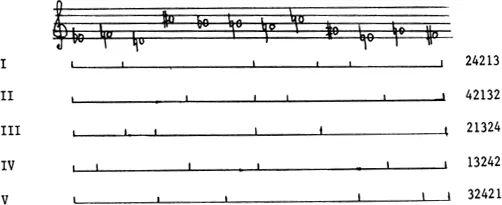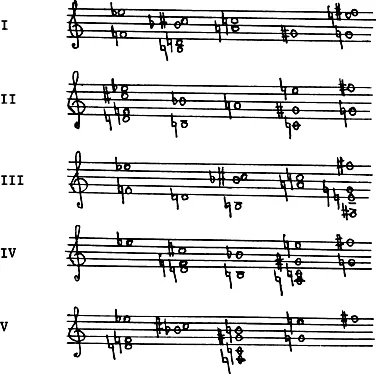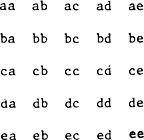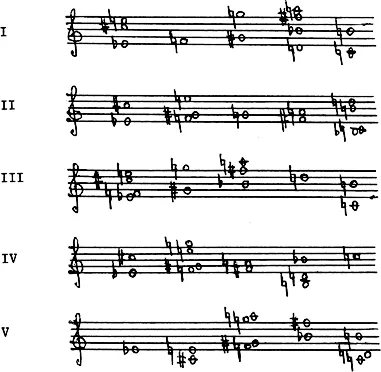
This is a test
- 244 pages
- English
- ePUB (mobile friendly)
- Available on iOS & Android
eBook - ePub
Book details
Book preview
Table of contents
Citations
About This Book
In this significant study of the music of Pierre Boulez, Dr. Koblyakov provides a complete analysis of Le Marteau sand Maître and deals with the development of serial music in the twentieth century and the problems of serial organization in general. He reaches stimulating conclusions about serial thinking and harmony in themusic of Pierre Boulez, thus enabling an understanding of the intricacies of this major composer's compositional techniques.
Frequently asked questions
At the moment all of our mobile-responsive ePub books are available to download via the app. Most of our PDFs are also available to download and we're working on making the final remaining ones downloadable now. Learn more here.
Both plans give you full access to the library and all of Perlego’s features. The only differences are the price and subscription period: With the annual plan you’ll save around 30% compared to 12 months on the monthly plan.
We are an online textbook subscription service, where you can get access to an entire online library for less than the price of a single book per month. With over 1 million books across 1000+ topics, we’ve got you covered! Learn more here.
Look out for the read-aloud symbol on your next book to see if you can listen to it. The read-aloud tool reads text aloud for you, highlighting the text as it is being read. You can pause it, speed it up and slow it down. Learn more here.
Yes, you can access Pierre Boulez by Lev Koblyakov in PDF and/or ePUB format, as well as other popular books in Media & Performing Arts & Music. We have over one million books available in our catalogue for you to explore.
Information
Chapter I
Analysis of the First Cycle
The first cycle of he marteau sans maître comprises the 1st, 3rd and 7th movements:
1. Avant L'artisanat furieux,
3. L'artisanat furieux,
7. Après L'artisanat furieux.
The 9th movement of marteau consists of three sections, the last of which is the coda (see bars 88–95, 100–102, 128–143, 154–158, 164–188). In organization this section is related to the first cycle of marteau and will therefore be discussed with it.
The whole of the first cycle and the coda of the 9th movement use the technique of frequency† multiplication, the frequencies making up a twelve-note series. This type of organization was used for the first time in the works of Boulez and it was created and developed by him. All the musical parameters: pitch, system of durations, dynamics, number of attacks, etc., are subjected to the common impact of this organization.
The pitch organization is based on one general series, which by different divisions creates an ensemble of series of frequency groups.‡ The general series as such is not included in the first cycle. The division of the general series into groups of frequencies is connected with the application of the proportion row 24213, which is consistently rotated, thus producing the following five derived series (each figure denotes the number of sounds in each group).
Each derived series has a one-sound group and the positions of these sounds (within the original series) divide the series by the same proportions but in reversed order (compare the proportion of Ex. 2 with row IV in Ex. 1a).
Each of the five marked sounds could become the basis of a transposition for its derived series. Boulez however starts by an additional pitch transposition of the derived series, with the exception of derived series IV, which keeps the E flat transposition. Series I and III go down by a major second, so they are based on the sounds F sharp and C natural instead of G sharp and D natural respectively. Series II and V go up by a minor second, so instead of the A natural and F sharp transpositions they

Ex. 1a

Ex. 1b

Ex. 2
will have B flat and G natural respectively.
Now each of the abovementioned series, by multiplication of frequency groups, creates five harmonic fields. Moreover, each frequency group in the derived series is multiplied by another frequency group, thus producing new groups. Since a series has five groups, multiplication results in twenty-five groups, ten of which appear twice. This can be denoted by letters.†

Ex. 3
E.g., to obtain block aa, group a is multiplied by itself, any repeated sounds appearing only once (see Ex. 4).

Ex. 4
The elimination of repeated sounds leads to the number of sounds in a group never being more than 12. When dividing the general series into five groups, as in the first cycle of marteau, the number of sounds in a group cannot in fact be more than 10.
With multiplication each of the five derived series is to produce five harmonic fields. Each system of five harmonic fields will be called a harmonic domain. Thus we have five domains (see Diagram I, where they are denoted by Roman numerals). This diagram shows that Boulez replaces in each domain the horizontal field a by a field consisting of a derived series.
Each domain has its system of blocks of different structure. Sometimes however identical blocks can be found, coinciding even in transposition, though belonging to different domains. Such a coincidence results from the existence of a single division system of the general series, as shown above. Each domain is based on the transposition of its derived series, which creates, so to speak, a higher system of pitch interrelation of domains: I, F sharp; II, B flat; III, C natural; IV, E flat; V, G natural.
Those domains can be found in the 1st, 3rd, and 7th movements of marteau, while for the coda of the 9th movement the composer uses the inversion of the general series and a row of proportions in retrograde order 31242 (see Ex. 5a and 5b).

Ex. 5a

Ex. 5b
One-sound groups create within this series the same interrelation of proportions, though in retrograde order (compare the proportion in Ex. 6 with the proportion from row V in Ex. 5a).

Ex. 6
These five sounds become transposition bases for their derived series, and then produce domains. In the coda of the 9th movement of marteau for each of the five domains only the harmonic fields b and d are used; that is why they are the only ones given in Diagram II.
Now we can begin the analysis of the general form and the description of the harmonic domains in the first cycle of marteau. The 1st movement of the composition includes five sections or nine subsections in which all the five domains are presented (see Ex. 7, and also the score appended).

Ex. 7
As seen in Ex. 7, all five sections create a symmetry by the number of fields included in them (13131). On the other hand, each domain is found to be used twice, the exception being domain I which reappears only in the 7th movement of marteau, which is built completely on this domain. Fermatas separate the five sections of the 1st movement and at the end of each domain (or subsection) there is a compression of tempo (presser) or its retardation (poco rit.), while each domain begins a tempo.† It is also noteworthy that by switching domains V and II a consecutive movement of domains from I to V appears; then a reverse movement of the domains begins (with bar 53), where domain II is between domains V and IV. Thus a concealed mirror symmetry is expressed, which exists also with the position of the domains (see also bars 21–52, domains III–IV–II, and bars 60–95, domains II–IV–III).
The 7th movement of marteau is something like a widened conclusion of the 1st; it also in...
Table of contents
- Cover
- Pierre Boulez A World of Harmony
- Contemporary Music Studies
- Full Title
- Copyright
- Contents
- Introduction to the Series
- Preface
- Introduction
- Chapter I Analysis of the First Cycle
- Chapter II Analysis of the Second Cycle
- Chapter III Analysis of the Third Cycle
- Conclusion
- Bibliography
- Comments
- Appendix:
- Le marteau sans maitre: Fragments of the Score with Analysis
- Index